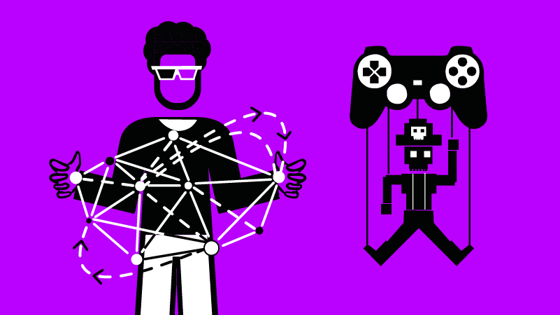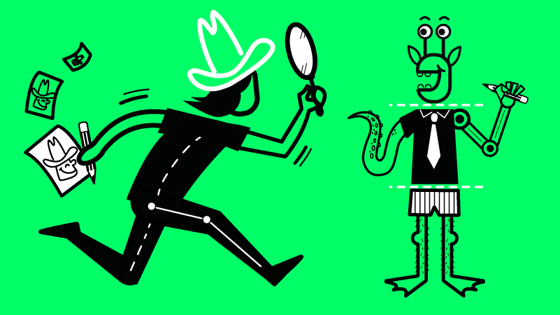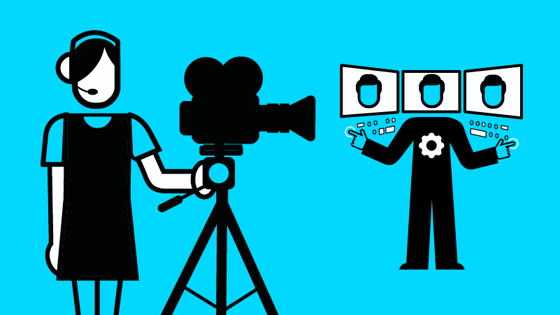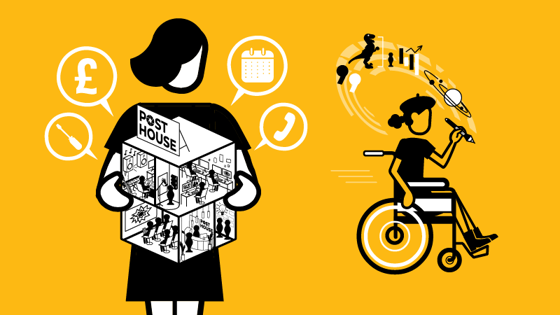Film and TV drama
Hair and make-up trainee
Also known as: Hair and make-up runner

What does a hair and make-up trainee do?
The role of hair and make-up trainees varies according to the production. Most start the day reading the call sheet and putting together kit bags depending on what’s needed. That might include anything from towels and hair dryers if there’s a water scene, or hot flannels for de-rigging at the end of the day.
Hair and make-up trainees learn by watching more experienced staff and might get to do basic hair and make-up for crowd scenes. They may even be responsible for some minor characters and stunt doubles, working under supervision. They are trained in health, safety and hygiene. They wash brushes, keep the truck tidy and make sure the towels are clean.
Hair and make-up trainees are also responsible for updating notes and taking photographs, which is essential to maintain the continuity of the characters during production.
Watch and read
What’s a hair and make-up trainee good at?
- Hair and make-up: be able to do basic hair dressing and make-up application
- Hair and make-up history: enjoy period fashions and styles as well as current trends, know how to research them
- Watching film and TV drama: have a passion for the medium and a love of the industry
- Learning by watching and asking: be able to observe what’s happening and ask questions at the appropriate moments
- Reliability: get to set on time and do what’s asked
- Communication: be able to put actors at their ease while they’re being made up, be able to listen to and communicate with crew members
Tools of the trade
You will build up your kit over time. To start with, get a set bag which should include:
- Hair styling brushes, such as a paddle brush, barrel brush and Denman brush
- Hair combs, such as a tail comb, wide tooth comb and cutting comb
- Set of make-up brushes
- Powders, puffs and sponges
- Tissues, wet wipes, cotton pads
- Hair dryer and straighteners
- Dry wax, sticky wax, wet gel
- Dry shampoo and hairspray
- Bobby pins
Who does a hair and make-up trainee work with?
Hair and make-up trainees work with the hair and make-up assistants and other members of the hair and make-up team. They will also be working with actors and supporting artists (people with non-speaking parts).
How do I become a hair and make-up trainee?
Hair and make-up designers usually enter the industry through one of three routes. Some come from hairdressing and barbering. Others come from beauty-therapy backgrounds. Other come from stage and theatre hair and make-up backgrounds. There are several different ways to get qualified before entering the industry. Once you have one of the following qualifications, you can apply to ScreenSkills’ Trainee Finder or find other ways of getting into the industry.
At school or college:
Take one of the following Level 3 qualifications:
- VTCT Diploma in Theatrical and Media Make-up
- City & Guilds Advanced Technical Diploma in Theatrical, Special Effects and Media Make-up Artistry
- City & Guilds Advanced Technical Diploma in Barbering
- City & Guilds Advanced Technical Diploma in Hairdressing
- City & Guilds Advanced Technical Diploma in Media Make-up Artistry
- City & Guilds Diploma in Barbering
- City & Guilds Diploma in Hairdressing for Colour Technicians
- City & Guilds Diploma in Hairdressing for Cutting and Styling Technicians
- City & Guilds Diploma in Women’s Hairdressing
- VTCT Diploma in Hairdressing for Colour Technicians
- VTCT Diploma in Theatrical and Special Effects and Hair and Media Makeup
- VTCT Diploma/Extended Diploma in Beauty Make-up Techniques
- VTCT Diploma/Extended Diploma in Hairdressing
- VTCT Diploma/Extended Diploma in Barbering
- VTCT Combined Diploma in Hairdressing
Get an apprenticeship:
An apprenticeship is a job with training, so it’s a great opportunity to earn as you learn.
In the past, it has been challenging to find jobs as an apprentice within production companies, although there is now a Hair, make-up, prosthetics and wigs apprenticeship standard specifically designed for people working in theatre or film and TV. It might also be worth looking for a job as an apprentice. This will help you develop your craft and create a body of work for a portfolio that you can use to find your way into film and TV drama at a later point. Check out What’s an apprenticeship? to learn more about apprenticeships and Find an apprenticeship to learn how to find one in your region, or approach companies directly. Go to ScreenSkills information on apprenticeships for the main apprenticeship schemes in film and television.
Get experience:
Work on a make-up concession stand. Get a part-time job in a hair salon or barbershop. Volunteer to do hair and make-up for student films or amateur theatre. The more time you can spend doing hair or make-up the better.
Build a portfolio:
This is essential. Go to Build a hair and make-up portfolio for details of how to do this.
Take a short course:
Hone your skills in hair and make-up by taking a specialist course. Go to the list of training courses recommended by ScreenSkills and see if there is one in prosthetics, barbering, wig-fitting or period hair styling. If you have a specialism, it will make you extra handy. We recognise courses with our ScreenSkills Select award where they offer training in the relevant software, dedicated time to building a portfolio and have strong links with the film and TV industries.
Become a trainee:
Apply to be a hair and make-up trainee. Get onto ScreenSkills’ Trainee Finder This will help you make the contacts and build up the industry knowledge to get work in the art department of a film or TV drama.
You might also be interested in…
Hair and make-up artists are in demand in unscripted TV as well as in film and TV drama. They are also needed for music videos, corporate films, fashion and advertising.







